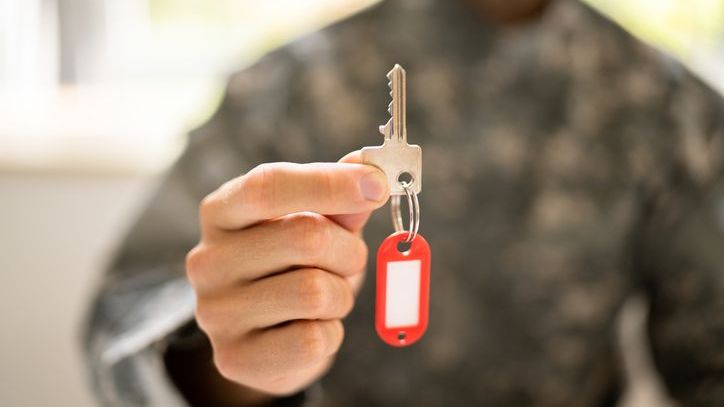
Veterans Affairs (VA) loans provide a pathway for veterans, active-duty service members and reservists to achieve homeownership with favorable terms. VA loans are known for their no down payment requirement and no private mortgage insurance, making them an attractive option for those who have served or continue to serve in the military. However, prospective applicants should know there are specific VA loan requirements that determine one’s eligibility, most notably the borrower’s military service history. Here’s a look at the 2024 eligibility requirement for VA loans.
If you’re thinking about buying a home, talk it over with a financial advisor first. Connect with a fiduciary advisor today.
VA Loan Basics
At its core, a VA loan is a mortgage option that the Department of Veterans Affairs (VA) guarantees. The VA loan program helps eligible American veterans or their surviving spouses obtain long-term financing to purchase a new home with no down payment and at competitive interest rates. However, VA loans can also be used to refinance or rehab an existing home.
The program’s history dates to 1944 when it was established as part of the original Servicemen’s Readjustment Act, also known as the GI Bill of Rights. Signed into law by President Franklin D. Roosevelt, the VA loan guarantee program was a significant acknowledgment of the sacrifices made by service members during World War II. It aimed to ease their transition back to civilian life by providing a tangible asset for their long-term financial stability.
VA loans offer financial benefits that distinguish them from conventional loans:
- No down payment required
- No PMI required, leading to lower monthly payments
- Competitive interest rates
While the benefits of VA loans are substantial, it’s also important to note potential drawbacks. For example, borrowers pay a VA funding fee that’s based on the type of loan, the size of their down payment and whether they’ve used a VA loan before. And while VA loans do not require a down payment or PMI, there may be other costs such as closing costs that the borrower should consider.
VA Loan Eligibility Requirements

To qualify for a VA loan, applicants must satisfy a series of requirements that include specific service criteria, obtaining a Certificate of Eligibility (COE), and meeting lender-specific credit and income standards.
Minimum Service Requirements
The VA loan program is designed to honor those who have served the country by providing them with benefits that facilitate the purchase of a home. To be eligible, applicants must meet the following service criteria:
- Active-duty members: Active-duty service members with at least 90 continuous days of service.
- Veterans: Minimum service requirements for veterans vary based on when they served. Generally, veterans may qualify if they served for 24 continuous months. Others may qualify if they served for either at least 90 or 181 continuous days of active duty.
- Reservists and National Guard members: Eligible after six years of service or after 90 days of active-duty service. Reservists who served before Aug. 2, 1990, also must have been discharged honorably or placed on the retired list, were transferred to the Standby Reserve or Ready Reserve, or continue to serve in the Selected Reserve.
Additionally, the program extends to the spouses of service members who have died in the line of duty or because of a service-related disability. There are exceptions to these requirements, including individuals who were discharged due to hardship, certain medical conditions, or a reduction in force, which underscores the program’s flexibility and commitment to serving those who have served.
When assessing your own potential eligibility, it’s important to visit the VA’s website and review the requirements associated with specific periods of service, as they can vary.
Certificate of Eligibility
The first step in securing a VA loan is obtaining a certificate of eligibility (COE), which serves as proof that the applicant meets the necessary service requirements.
The COE verifies an applicant’s entitlement to the VA loan benefits and is a prerequisite for moving forward in the loan application process. It confirms the veteran’s eligibility and the amount of VA entitlement, which directly impacts the funding fee and the loan amount.
To streamline the process, here is a step-by-step guide to obtaining your COE:
- Gather necessary documentation, such as proof of military service or current statements of service.
- Apply using the VA’s eBenefits portal, by mail or through a VA-approved lender.
- Submit VA Form 26-1880 along with the required documentation.
Credit and Income Requirements
The VA does not set a minimum credit score but lenders typically have their own requirements. Lenders commonly seek a credit score of at least 620, although there is some flexibility. For example, lenders may consider compensating factors such as a veteran’s savings or their history of making rent payments on time when evaluating lower credit scores.
Despite this flexibility, lenders conduct a comprehensive review of an applicant’s credit history to ensure that the individual has demonstrated responsible borrowing behavior and is likely to manage mortgage obligations effectively.
Lenders also require proof of stable and sufficient income to ensure that applicants can sustain their mortgage payments. This typically involves submitting recent pay stubs, W-2 forms and tax returns. For self-employed individuals, the documentation may extend to profit and loss statements and other business-related financial records.
A key metric that lenders evaluate is the debt-to-income ratio, which compares an applicant’s total debt to their income. This ratio is used to determine whether the borrower’s financial obligations are manageable, with a common threshold being a debt-to-income ratio under forty-one percent. But while the VA loan program offers flexibility, it does not guarantee loan approval, and each applicant’s financial situation is thoroughly assessed.
Property Requirements
The VA loan program is designed to facilitate the purchase of a primary residence, and as such, it encompasses a range of eligible property types. These include single-family homes, condominiums, modular homes and certain multi-unit properties. However, it is important to note that the program does not extend to vacation homes or investment properties.
To qualify for a VA loan, the property must adhere to the VA’s Minimum Property Requirements (MPRs), which are in place to ensure the safety, sanitation and structural soundness of the home. These standards are a safeguard for both the borrower and the lender, ensuring that the property is a sound investment and a safe dwelling.
A VA appraisal is an obligatory component of the loan process, serving to evaluate the property’s market value and condition. This appraisal is distinct from a standard home inspection in that it focuses on identifying issues that could impact the home’s value or pose hazards to occupants.
Applying for a VA Loan
Applying for a VA loan involves several steps, some of which are identical to the conventional loan application process. Here’s a step-by-step look at how to apply for a VA loan:
- Obtain your COE: As mentioned, this is critical for proving your eligibility.
- Pre-approval: Get pre-approved by a lender who participates in the VA home loan program. This involves verifying your credit and income information.
- Find a home: Work with a real estate agent to find a property that meets your needs and passes the VA’s MPRs.
- Complete the loan application and underwriting: Your lender will process your application and coordinate an appraisal.
- Closing: Once approved, you’ll sign all necessary paperwork and close on your new home.
Bottom Line

Dating back to the WWII era, the VA loan program has evolved to include a variety of loan types and expanded eligibility criteria, ensuring that veterans, active service members and certain spouses can achieve the American dream of owning a home. To be eligible for a VA loan, prospective borrowers must obtain their certificate of eligible from the Department of Veterans Affairs, which verifies that they’ve satisfied specific service requirements. Additionally, they must find a home that qualifies for a VA loan, as well as meet income and credit score requirements set by individual lenders.
Mortgage Tips
- Whether you’re looking to buy a home with a conventional mortgage, an FHA loan or a VA loan, it’s important to shop around for the most attractive terms and interest rate. SmartAsset’s mortgage rate table can help you compare rates and potentially find one that works for your financial situation.
- Buying a home may be the largest financial transaction you’ll make. It helps to have a financial expert in your corner helping you plan for this major investment so it aligns with your overall economic picture. Finding a financial advisor doesn’t have to be hard. SmartAsset’s free tool matches you with up to three vetted financial advisors who serve your area, and you can have a free introductory call with your advisor matches to decide which one you feel is right for you. If you’re ready to find an advisor who can help you achieve your financial goals, get started now.
Photo credit: ©iStock.com/SDI Productions, ©iStock.com/PixelsEffect, ©iStock.com/AndreyPopov